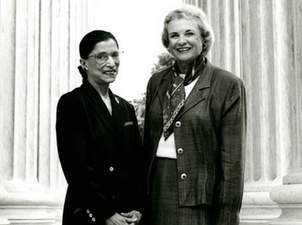
Women in Justice
Claudia Brock
March 5, 2018
It all started with a campaign promise. While Ronald Regan was running for president, he made an effort to court the female vote by pledging that he would nominate the most qualified woman he could find to the Supreme Court. When Justice Potter Stewart retired in 1981, it was time for President Regan to fulfill that promise. The appointment of Justice Sandra Day O’Connor was historic as she became the first woman to serve on the highest court in the land, almost 200 years after the Supreme Court had been established.
March is Women’s History Month and appropriately the birthday month of both Justice Sandra Day O’Connor (celebrating her 88th birthday on March 26) and Justice Ruth Bader Ginsburg (celebrating her 85th birthday on March 15). Both the first and second female Justices have made remarkable contributions to women’s history, in their decisions from the bench and in championing the way for other women in law.
In an interview with the New York Times, Justice Ruth Bader Ginsburg said “I always thought that there was nothing an antifeminist would want more than to have women only in women’s organizations, in their own little corner empathizing with each other and not touching a man’s world. If you’re going to change things, you have to be with the people who hold the levers.”
You do not have to look far to find these “women’s organizations” that Justice Ginsburg is talking about. The majority of the nonprofit employees, over 75%, are female, over 75% of K-12 teachers are female, and over 80% of social workers are female. While women have been disproportionally excluded from political, business, and religious leadership roles, concern for community seems to be a powerful stimulus for women pursuing direct service careers.
But women seem to have been galvanized by an environment of support and the inspiration of female trailblazers to expand their concept of community. There are twice as many women running for Congress in 2018 than there were in 2016. Likewise, Justice O’Connor is credited with inspiring a generation of women to attend law school. When she was appointed in 1981, 36% of law school students were female and when she retired in 2006 the number had risen to 48%. Visibility begets action.
I will be attending law school in the fall and while I am so looking forward to my future career as a lawyer I have been surprised by how many people have asked me, “Are you sure?” when I say I am attending law school. And while this reaction is nowhere near as awful as the dean of Harvard Law School asking Justice Ginsburg and her eight other female classmates (out of class of 500!), “How do you justify taking a spot from a qualified man?” I am still put off by this reaction. I have gotten it from both men and women, beloved family members, and trusted mentors. When I talk about my future plans I am met with a cocked head, squinted eyes, and vocal inflections that communicate both concern and distrust that I have thought everything through.
But yes, I am sure. Just as Justice Ginsburg instructed, I hope to be with the people who hold the levers, and I think I and many other women are working for a day when we hold the levers too and make decisions that take into account the needs of all, not only the powerful.







